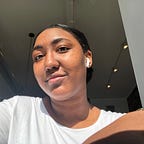Color, color, color… beauty.
This trip was my second time visiting the exhibit and I went through it with a completely new set of emotions and perspective. When I got off the blue bus and waited for my classmates I found myself feeling quiet. I was not excited, happy, or mad. I wanted to go, but I didn’t approach it with expectations. My first time going, I did. I was expecting beautiful African Art, and that’s exactly what I got. I wasn’t thinking critically and I wasn’t bringing myself into it. I brought my camera, but every picture I took was formulated. I knew what I wanted to capture, I knew what I wanted to feel — just art. I wanted a surface level of beauty, form, and artistic expression. It was important for me to know how to move in the space and appreciate the aesthetic. However, this time, aesthetic was not enough for me.
This time around was incredibly different and it left me feeling open, charged, connected, and so much more. I spoke to Nyasa, a classmate, before getting in the van and we talked about colorism — more specifically, dark skin girls. I will not go into the specifics of what we spoke of, but rather, the lesson I learned. Which was that it was time for me to stop ignoring my complexion. I always knew I was darker. I have had countless times when friends, white, black, asian, hispanic, and more, have told me that my family and I were clearly darker. While it shouldn’t have, it hurt me. My complexion was a joke to so many people. Whenever I thought of beauty, it always made me take a pause when it came to thinking of myself. As much as I wanted it to, pretty couldn’t be associated with my complexion.. with my aesthetic. Even though, I’m 5'10, thick, and dark-skin, I was always invisible. I knew race existed and I was not color blind. I’ve always knew color was there. But for a long time, just like Sethe in Beloved, I could not see color. And I did not have the skills, energy, or power to find out why, vocalize why, and advocate for why.
However, speaking to Nyasa that morning and going to the exhibit re-wired that structure and dynamic I implanted in my head. As soon as we got the go-ahead from Monique to roam, I went immediately to the Look Again: Contemporary Perspectives on African Art Exhibit. I pulled out my camera and moleskin and went to work. I was drawn to the power figures. There was one from the Kongo Kingdom. This man made of wood, glass, and fiber stood with all of these nails impaled in his torso. His facial expression screams pain, screams honor, screams presence. I saw him, and even more, I saw his color. What made me want to take the photo from various angles was the color of the wood. I journeyed in and out of the browns, just to find lines of black, yellow, and red. I stood in front of him and to his side in awe, and with each snapshot I got new colors. It was fulfilling, but still not enough.
When I went to the Vlisco exhibit, I noticed color. All of the mannequins (except for one, who was a male with no head) were dark skin women. But then I questioned, how is it that I still do not see myself, or my mother, or my grandmother, or my friends? Was this going to be our representation? I understand that I am African-American. I’m from Jersey. But something’s missing there. The colors brought up questions of home for me, and it depressed me to realize that that is a history that is so untraceable, so opaque, and hidden. So many questions, and so few answers. I was beginning to feel the triggers so I took a step out.
Then I began seeing the architecture section, more specifically the colorful strings. It brought utter joy to my rollercoaster of emotions that afternoon. Then I saw Nyasa, Amaka, and Hannah by the strings and I just had to take pictures of them. In that moment, I saw color is so many different ways. It was more than just the color of their skin against the greens, yellows, pinks, blues, and more. But it was the color in their joys, smiles, outfits, movements, and intertwining with the strings. I just had to capture it and it sparked so much for me, creatively and personally.
Creative Africa for a second time provided a wealth of knowledge and material for me. It was triggering but rewarding, and even problematic, given colonial influences and power dynamics, but remained intriguing. If I’m leaving with anything, it is that art is presented for us to do the work. We have to use aesthetic, the form, and the color to unpack, to re-tell, and to transform.
